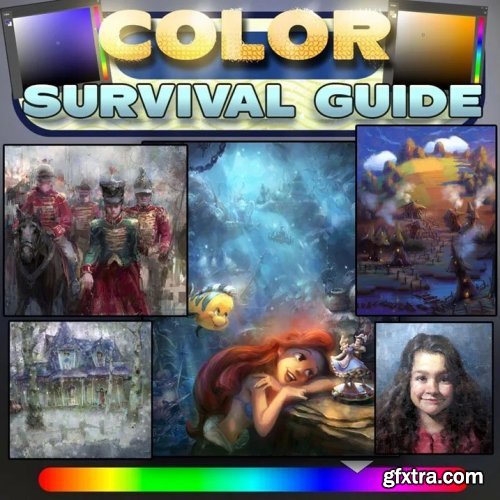
The Color Survival Guide
https://www.skillshare.com/classes/The-Color-Survival-Guide/1874745266
'The Color Survival Guide' features a selection of color theories and color principles that I use almost every day as a commercial artist. I've selected the things that work and are useful and reliable, time and time again.
In six (6) chapters, distinct principles will be explained in depth. In each chapter you will get a presentation featuring the background color theory of the principle in question, as well as a painting demonstration of where & how I use it in my work and how you can apply it yourself! Chapter 1: Complementary Palette:
Table of Contents:
Learn how color moves by reducing your palette to two simple complementary colors. You will learn invaluable lessons of how colors "cross" from one side of the color wheel to the other, and how important that transition is. These principles can be applied to more complex palettes.
Chapter 2: Color Temperature: Warm vs. Cool
The mother of all color theories! If you don't know how color temperature works, you likely won't get reliable or believable color in your art. This chapter breaks down the essentials of how warm moves to cool (and vice versa) through photo studies and painted studies.
Chapter 3: Color Temperature: Moving Across The Spectrum
With warm vs. cool under our belts, we now look at more ways that nature moves between the two extremes. At this point in the class we now have the tools to understand nature, paint it faithfully, as well as the tools to caricature it to meet our own aesthetics!
Chapter 4: Color Vibrations
Oftentimes we have to deal with elements that appear to have solid local colors. A red apple, for instance. But how does nature actually treat "flat" colors? This chapter will give you important models for understanding how to keep colors active and interesting, yet still reading as simple, singular colors.
Chapter 5: Color Palettes
Now that we have a command of color theory and practice, we can use it to apply all sorts of different palettes. We began this class with a simple complementary palette, but now we have access to much more! We'll look at how different palettes affect the mood of a piece, as well as how you might pair certain palettes with certain lighting conditions.
Chapter 6: Study Tips & Advice
Watching a painting class is one thing, but we need to instill good practice habits in order for you to take this information and allow it to flourish over time. This chapter will suggest simple ideas for daily practice. You will be able to use these methods to simplify the study of all the ideas and theories presented in the class. This chapter will be especially useful for those still getting their feet wet with these color theories, and need a way to practice without overcommitting to finished paintings right away.
Top Rated News
- Sean Archer
- AwTeaches
- Learn Squared
- PhotoWhoa
- Houdini-Course
- Photigy
- August Dering Photography
- StudioGuti
- Creatoom
- Creature Art Teacher
- Creator Foundry
- Patreon Collections
- Udemy - Turkce
- BigFilms
- Jerry Ghionis
- ACIDBITE
- BigMediumSmall
- Boom Library
- Globe Plants
- Unleashed Education
- The School of Photography
- Visual Education
- LeartesStudios - Cosmos
- All Veer Fancy Collection!
- All OJO Images
- All ZZVe Vectors




